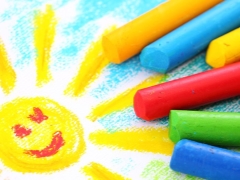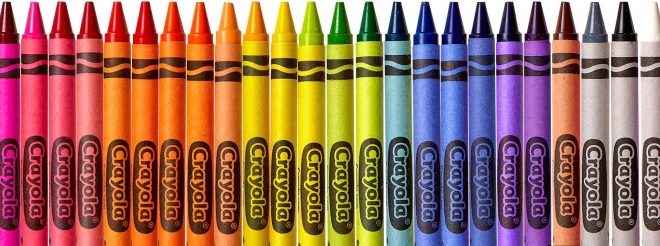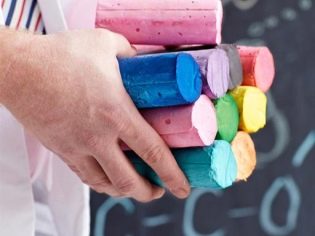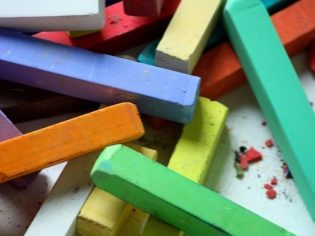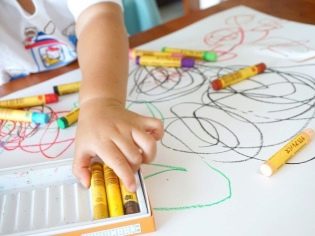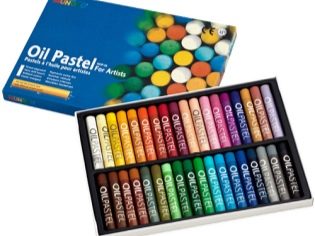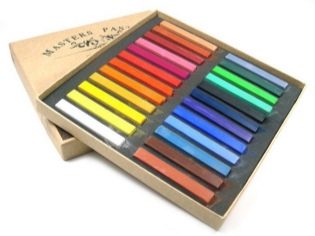How to choose crayons for drawing?
A typical children's fascination with creativity for a long time by the majority of people was considered not the most rewarding pastime, but in recent decades, experts have proven the use of such a hobby for the all-round development of a child. However, some types of creativity, for example, watercolor, are considered to be a suitable exercise for maturing adolescents. But crayons for drawing are still perceived as exclusively children's tools, not intended for serious arts.
It should be noted that in fact this is not entirely true. The benefits of using chalk are huge, so buying such products is worth it.
Why exactly chalk?
You can draw by various means, but children often choose crayons. In many ways, the lack of understanding of the advantages of chalk is due to the fact that the older generation still regards it as a means for drawing on asphalt. However, today the scope of application of crayons is already much wider. Children like them for several reasons.
- Undemanding to the surface. Nowadays, good colored crayons make it possible to paint not only on asphalt. Some varieties are well suited for drawing on paper. Often parents buy them for an easel (the surface covered with special enamel, which allows you to draw directly on the board). This material can be drawn even on the wall.
- Brightness shades. Ordinary Soviet children’s crayons were rather faded and uninteresting, but today the drawings of some varieties of crayons look like full-fledged oil paintings. Coal, pastel, wax crayons - all these types give different results, so they can replace the entire range of other drawing tools.
- Convenience. For the youngest children, parents themselves often choose crayons as their first creative gift. The fact is that a pencil or brush still needs to be learned to hold in hands, while the chalk leaves a mark on either side. This allows you to draw even kids at the age of one year, who are not yet able to create masterpieces, but they can already begin to learn colors and train fine motor skills of hands.
- The possibility of the development of technology. Leading global manufacturers have long noted the wide popularity of crayons, so they began to produce them in various forms. The set can include large or small elements, have the appearance of sticks, triangles or even shapeless "stones", which can be sharpened at their own discretion. For the most complex techniques, pastel or wax based pencils are produced, the filler of which is crayon.
- Relative ease of purification. If you "discard" products on a fatty basis, you can pick up the classic chalk, perfectly washable with water. This argument is hardly taken into account by the young artists themselves, but for parents, there is a point in buying an easily washable artistic tool. In addition, this composition is suitable for use in the bathroom (for example, a set of Bath art), allowing you to paint even water, which will definitely be appreciated by kids.
Not to mention another important argument for parents - ordinary crayons without a professional fitness claim will cost a penny to the family budget.
Varieties
It should be noted that modern chalk means not the chalk that is still used in general education schools for writing on the blackboard.As a rule, it is a mixture of several ingredients, each of which is aimed at giving the substance of those or other necessary properties.
Today, crayons are of several types, but most often there are three main ones.
- Classic chalk. Despite the fact that it got its name due to the natural substance of the same name, in fact, the percentage of chalk in such objects is usually small. In any case, grated chalk is used with the addition of fillers (gypsum, clay, alabaster), binders (carpenter glue, gum arabic, dextrin, oat paste and even brewer's yeast) and dyes. Slight addition of soap is also possible to soften the substance. This solution is considered primitive and is used to paint exclusively on solid surfaces like boards or asphalt.
Because of the significant percentage of clay in the composition, drawing on asphalt is difficult. It is this type of chalk that is easiest to wash off clothing or other surfaces into which it is not absorbed.
- Wax crayons. This variety is a slightly improved classic recipe, a binder in which beeswax acts. The use of wax allows the chalk stick to be made less fragile, and also to give the flowers an increased saturation. Contrary to its greasy, felt to the touch, wax crayons do not leave colored marks on their hands. However, the dirt left by them on the fabric or wallpaper will be extremely difficult to clean. The downside is the higher price, although the collected crumbs can be melted in the oven and reused to form new crayons.
- Oil Pastels. A significant amount of natural oil is added to this recipe to soften the consistency, thanks to which another interesting effect is achieved - the drawings in this small color resemble a real painting and are distinguished by their contrasting shades. Ordinary pastel, designed for children's use, is relatively inexpensive, but it gets dirty very much. She is able to leave colored traces even on her hands.
For greater accuracy of work, manufacturers often produce baby pastels in special plastic cases, which allow them to protect a rather soft product from damage. Unlike the two previous types of crayons, oil pastel is even professional and very expensive.
Due to the fact that on paper it looks like paint, many professionals use it to draw small parts and create sketches. For children's creativity, dry or watercolor pastels can also be used.
What to look for when choosing?
The range of such products on the modern market is quite large, and ignorant people do not always know how to distinguish a quality product from what is not worth buying. There are several criteria for choosing good crayons for a child.
- View. When choosing, one should make a start from the type of surfaces on which future owners of crayons will draw. If the child is small and draws wherever he pleases, it is better to give preference to the classics. If we are talking about the work of a decent level, it makes sense to buy pastel.
- The form. The main advantage of chalk for children's creativity is the ability to write by any party. Therefore, for the smallest you need to choose only open shapes in the form of sticks or stones. At the same time, you should definitely take into account the size of the baby’s hand so that he can hold such a tool in it. If the child is already at least 3 years old, you can gradually switch to forms that imitate a pencil. This will help to achieve higher detail imaging.
- Composition. Parents of young children should study the composition of literally everything they are going to purchase. Children under 3 years old should never buy crayons even with a small amount of harmful synthetic components. In particular, wax crayons must contain exactly natural wax, and not paraffin. This is due to the desperate desire of the little ones. to try everything is “hard”, however, even after reaching the age of three, synthetics in the composition are not considered a plus for crayons, unless it is the only way to achieve complex creative goals.
- Color palette. The properties of crayons do not allow manufacturers to produce full-color kits, as is the case with water based or oil based paints. However, still there are kits for sale, including a couple of dozen shades. The youngest children do not need such delights. Six colors will be enough for them, so long as they are bright. Increase the number of shades in the set is only as the child grows.
- Additional devices. If crayons are bought not only for asphalt, you should pay special attention to the kits, which include additional tools. Such additions include, for example, a knife for sharpening crayons and a case for storing them, an album of special paper for oil pastels, etc.
Having received a whole set as a gift, the child begins to feel responsible for it, so he stops drawing in places inappropriate for this.
Manufacturers
For many parents who do not understand these products, only the company name can say something about the quality of crayons.
You can start with the products of Russian manufacturers. Brands "Gamma" and "Ray" are known to any parents. In the assortment of both firms there are small ones. Products for the Aqua-Color, Olki and Spektr companies are also suitable for children's needs, and for small but more serious artists you can buy small pieces of Podolsk-Art-Center or Sonnet.
If you can pay a little more, you should give preference to foreign manufacturers, for example, the famous Czech Koh-I-Noor. Higher quality are considered other well-known brands: ArtBerry, Faber-Castell, Conte, Lyra, Crayon, Maped, Silwerhof and Giotto. If a child has a clear talent, it is worth taking Talles or Mungyo products, while Sennelier Rembrandt or Schminke is already a gift worthy of even a professional.
To learn how to make colored crayons for drawing at home, see the following video.
